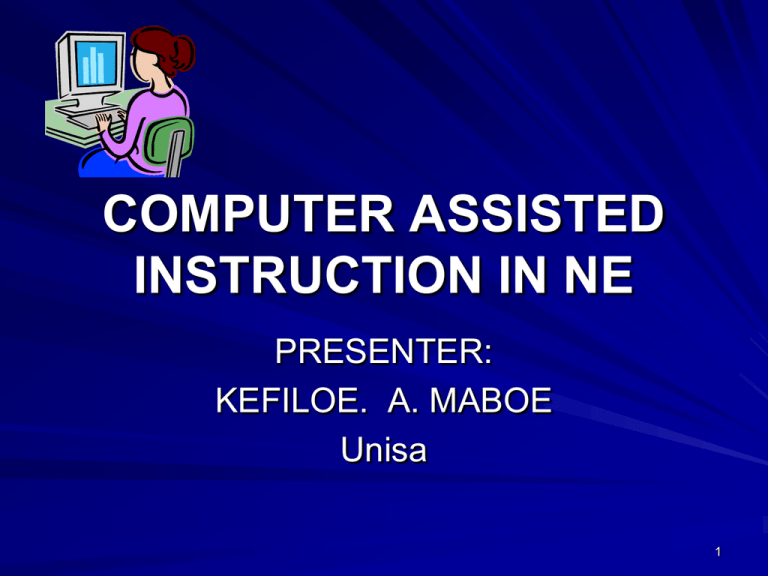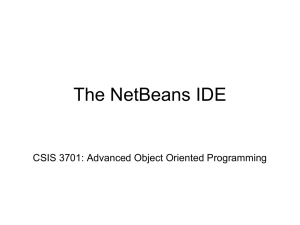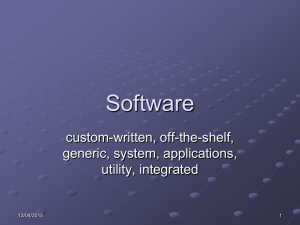COMPUTER ASSISTED INSTRUCTION IN NE
advertisement

COMPUTER ASSISTED INSTRUCTION IN NE PRESENTER: KEFILOE. A. MABOE Unisa 1 1: The challenge 2 The modern world Nurse educators are faced by the challenges to prepare students for life and work in an information, communication and technologically driven world Constant innovations and revolutionary changes due to scientific and technological explosion Digital revolution Satellite technology Wireless communication Scientific discoveries and inventions 3 The modern world (cont.) WWW facilitated interconnectedness on a worldwide basis and facilitate rapid change through speed in communication: Email Social networks 4 The modern health care setting Technologically advanced health care equipment for diagnosing and rendering care Digitalisation Electronic health information systems Emergence of enterprise and electronic communications including electronic patient record 5 The modern health care setting (cont.) Computer networks and communication technologies altered how providers and consumers of health gain access to and disseminate data and information Internet – its healthcare networks link caregivers and patients by providing health tools and e-commerce to them E-commerce enables individuals to monitor their health status, report health data and access disease prevention resources Telemedicine –ICT to provide and support health care when healthcare providers are geographically separated 6 Challenges Students are recruited from the society and need to be educated to serve the societal needs and to cope with the challenges posed by the health and social context. Educators should create opportunities for students to develop the necessary competencies: Information management skills storing, manipulating, retrieving criticising, utilising and disseminating information Technological mind, interest and abilities: Computer literacy and skills - ability to utilise ICT Ability to use electronic health information systems Ability to use advanced health care equipment Ability to operate in virtual realities 7 Challenges (cont.) Ability to adapt to constant changes and developments: flexibility, creativity, ability to manage confusion Independent learning skills: responsibility, curiosity and initiative as far as learning is concerned 8 2: The proposal 9 Proposal A paradigm shift by redirecting the emphasis from traditional methods of instruction to computer assisted instruction (CAI) to facilitate computer-based learning (CBL) in the classroom-setting CAI is referred to, as an individualised method of selfstudy using information communication technologies of which the computer is an essential part to deliver an educational activity CBL is a term used to cover the utilisation of a wide variety of teaching applications, which provide students with interactive learning experiences while utilising electronic information, communication and educational resources 10 3: CAI 11 DEVELOPMENTS IN THE FIELDS OF ICT AND CAI ICT electronic tubes stand-alone computers multimedia computers Education: Text-based computer- based learning Multimedia computerbased learning 12 DEVELOPMENTS IN THE FIELDS OF ICT AND CAI (cont.) Computer networks: – Local area network – internet and WWW ICT-based communication: – – – – – E-mail Bulletin boards Chatting Video-conferencing Social networks Learning experienced in a networked computer laboratory Utilising the internet: – Information access – Self-directed learning – Interdependent, collaborative learning Virtual classroom and online learning 13 Characteristics of CAI Promoting interactive learning: presenting interactive learning material in text and/or multimedia format facilitating interactive learning activities by utilising videoconferencing facilities facilitating interaction with peers and experts in virtual reality Promoting educational management: establishing electronic databases for diagnosing learning needs and problems providing for automated learning assessment and remedial activities Providing additional learning opportunities: providing supplementary electronic learning material in addition to the traditional textbook facilitating information searches by using the Internet 14 Theoretical foundations of CAI Behaviourism: Behaviour is defined as a muscle movement. It is a result of a series of conditioned reflexes, emotions and thought processes Learning is demonstrated through observable behavioural changes Behavioural theorists propose that stimulus– response bonds are strengthened by reinforcement. 15 Theoretical foundations of CAI (cont.) Educators who adhere to the behaviourist approach would apply computer assisted instruction that is based on the principles of programmed learning, mastery learning, and drill and practice Constructivism: Is based on the premise that knowledge cannot be transferred from one person to another but is rather constructed by the learner. Knowledge is an understanding, which is generated from past and present learning experiences. 16 Theoretical foundations of CAI (cont) Constructivism (cont.): Supports student-centered learning Supports inquiry-based learning. The educator mediates between information-communication technologies, learning experiences, the learning content and the students 17 Theoretical foundations of CAI (cont) Constructivism (cont.) Cognitive constructivism focuses on how an individual student gains understanding of things, and social constructivism emphasises that meanings and understandings grow out of social encounters Multimedia technologies and learning packages which support discovery learning, problem-based learning and simulations are in accordance with constructivism. Social constructivism can be applied in computer assisted instruction by utilising the principles of collaborative learning 18 Educational approaches Mastery learning and programmed learning: Mastery learning is based on behaviourism Its main goal is the attainment of excellence of performance It is premised on the assumption that all tasks can be learned by students provided they are exposed to the appropriate stimuli, and are given sufficient time to master the content. 19 Educational approaches (cont) Mastery learning can be facilitated through programmed learning. The fundamental notion of programmed learning is that of reinforcement of learning. Programmed learning is applied through electronic self-learning modules with built in feedback, remediation reinforcement of learning. A self-learning module is a self-contained unit or package of study materials, which students study on an individual basis. Students proceed through a pre-test, learning outcomes, content, activities, post-test. Successful completion of one level of learning is required to proceed to a higher level. The computer automatically keeps record of the students’ progress. 20 Educational approaches (cont) Discovery learning Discovery learning is an educational approach during which educators create opportunities for students to embark on a process of self-directed inquiry, which would result in learning. Discovery learning is predicated on the existence of an intrinsic motivation, in humans, to learn. Discovery learning is promoted: by challenging the students to obtain information or seek answers to difficult questions by using the information and communication properties of the internet, for example through gaming which require the discovery or certain information or solutions in order to proceed through the game 21 Educational approaches (cont) Problem-based learning Involves confronting students with real life problems that provide a stimulus for critical thinking and self-directed learning Can be utilised in conjunction with discovery learning Recent advances in ICT and educational software, paved the way for the development of computer-based multimedia learning packages that use complex scenarios which are aimed at helping the students in developing clinical judgement and problem solving skills. Various printed and electronic resources are utilised to solve given problems or make appropriate decisions. 22 Educational approaches (cont.) Gaming Multimedia computer technology supports the gaming teaching strategy. Students can use individual or networked computers. Electronic educational games focus on either the content or the process of learning. Content games focus on teaching or reinforcing factual information. Process games are those that emphasise problem solving, decision-making or application of information. Networks and the Internet enable groups of students to participate without the players having to use the same computer, or having to share a geographical space. 23 Educational approaches (cont.) Simulation Is an imitation of some facets of life, usually in a simplified form. Aims to put students in a position where they can experience some aspect of real life by becoming involved in activities that are closely related to it. A simulated clinical situation can be created in virtual reality in which students interact with a virtual world. They obtain automatic feedback on their decisions and actions and have the opportunity to rectify poor decisions and actions 24 . Educational approaches (cont.) Collaborative learning Provides opportunities for teams of students to cooperatively complete their learning assignments, or engage in problem-based learning. The students can form face-to-face or virtual groups. Collaborative learning can be promoted in virtual reality by establishing an interdependent, interactive learning environment and by creating a virtual classroom. Communication can be verbal, or electronic through email, blogs, chatting, and video conferencing. 25 4: The current situation in NE 26 Current realities in nursing education: completed research A quantitative descriptive study involving second and third year students was conducted at a specific nursing college to answer the questions: What is the nature of the students’ exposure to CAI and CBL How do they perceive the benefits of this exposure and What problems do they encounter during CBI and CBL 27 Aim of the study to formulate guidelines for the expansion of existing CAI and computer based learning, to optimise the utilisation of informationcommunication technologies in NE to ensure that CAI and CBL are based on sound educational principles 28 The study Sample: 172 second year students 119 third year students All respondents had previously been exposed to CAI during the course of their studies Structured data collection approach utilising a structured questionnaire was used 29 The study (cont.) Data collection elicited descriptive data, Data obtained were submitted to descriptive data analysis, Some comparisons were made between the responses of the second year and third year respondents. 30 Findings Limited computer literacy: Inadequate levels of computer literacy many respondents were unable to effectively utilise the learning opportunities associated with CAI Limited access: to media centre in the college to information communication technologies at home to information communication technologies at or at the clinical institutions where students worked Preference: both group of respondents preferred CAI above traditional teaching strategies. However, respondents indicated that informationcommunication technologies were mainly not utilised for electronic communication or on-line learning 31 Findings (cont.) Type of engagement: – Were collaboratively engaged in CBL at the media center of the college Exposure to software - the frequency of exposure to computer packages appeared to be in favour of the third year respondents than second year respondents – Utilised software packages: Reading skills packages mainly by 3rd year students – Under-utilised software packages: typing skills packages computer literacy packages text-based computer packages with problem-solving scenarios Computer packages which enable respondents to achieve their learning objectives through game-playing 32 Findings (cont.) – Non-utilised software packages: Text-based course content packages Multimedia course content packages Multimedia packages with problem-solving scenarios Packages simulating clinical situations which develop respondents’ decision-making skills Learning resources utilisation: – Under-utilised learning resources: Using internet for information access 33 Findings (cont.) – Non-utilised learning resources: Obtaining information from CD-ROM packages Communicating with their peers by e-mail Communicating with their tutors by e-mail Communicating with field experts by e-mail Participating in on-line chatting with their peers Participating in video-conferencing with their peers Participating in video-conferencing with their tutors Exchanging information with their peers by e-mail Exchanging information with their tutors by e-mail Participating in electronic chatting for educational purposes Doing courses following an on-line learning approach 34 Findings: benefits not materialised according to many respondents 2nd year respondents: Being in control of their learning Flexibility in terms of study time Flexibility in terms of learning pace Repetitive learning A learning climate supportive of learning from mistakes Increased reading skills Achieving their learning objectives through text-based problem oriented computer packages Achieving their learning objectives by using the Internet to obtain information Engaging in collaborative learning Decreased boredom compared to traditional teaching Extended interaction with the learning Material Mastering the learning content Increased problem solving skills Experiencing satisfaction during the learning process 3 rd year respondents Flexibility in terms of study time Flexibility in terms of learning pace Increased reading skills Achieving their learning objectives through text-based course content computer packages. Achieving their learning objectives through text-based problem oriented computer packages Engaging in collaborative learning Mastering the learning content Receiving quality education 35 Findings: benefits not materialised at all 2nd year respondents: Flexibility in terms of resting time when their concentration wavers Experiencing decreased peer pressure Experiencing decreased educator pressure Achieving their learning objectives through text-based course content computer packages. Achieving their learning objectives through multimedia course content computer packages. Achieving their learning objectives through multimedia problem oriented computer packages Achieving their learning objectives through computer packages simulating clinical situations which develop respondents’ decision making skills. Achieving their learning objectives through computer-gaming packages Extended electronic communication with their peers Extended electronic communication with their tutors Extended electronic communication with field experts 3 rd year respondents Flexibility in terms of resting time when their concentration wavers Experiencing decreased peer pressure Experiencing decreased educator pressure Achieving their learning objectives through multimedia course content computer packages. Achieving their learning objectives through multimedia problem oriented computer packages Achieving their learning objectives through computer packages simulating clinical situations which develop respondents’ decision making skills. Achieving their learning objectives through computer-gaming packages Extended electronic communication with their peers Extended electronic communication with their tutors Extended electronic communication with field experts 36 Findings: Problems requiring priority attention Struggling to remain up-to-date with developments in computer technology Unaffordability of the necessary computer equipment A lack of computer facilities hampering respondents’ access to computer assisted instruction Insufficient technical assistance in the media centre Struggling to increase personal contact with peers Struggling to increase personal contact with their tutors Struggling to remain up-to-date with developments in computer technology Unaffordability of the necessary computer equipment A lack of computer facilities hampering respondents’ access to computer assisted instruction Unreliable computer equipment in the media centre Insufficient technical assistance in the media centre Achieving learning objectives through text-based computer packages which provide scenarios that develop respondents’ problem solving skills Achieving learning objectives through computer packages simulating clinical situations which develop respondents’ decision-making skills Increasing personal contact with their tutors 37 Conclusion The utilisation of ICT for CAI and CBL was still at its infancy. Although students preferred CAI over traditional methods of teaching accessibility to ICT and educational software were inadequate. There is a need for the development of CAI and CBL which are underpinned by sound educational principles since the educators failed to: – effectively implement the principles of constructivism, selfdirected learning, collaborative learning – establish a flexible learning climate in terms of study time and pace. – promote electronic interaction and communication, and electronic information exchange 38 Conclusions (cont.) ICT was mainly used to enable students to store and retrieve information, which is important for effective learning. However, seeking, storing and retrieving of information is merely one of many ICT educational applications are merely supportive of the development of higher cognitive skills and can therefore be a means to an end and not and end in itself 39 5: Recommendations 40 Recommendations: Nurse educators In-service education programmes need to be developed to improve nurse educators’ computer literacy and facilitation skills, which support effective CAI. The principles of constructivism, computer assisted instruction and computer-based learning should be included in the curriculum for nurse educator training. 41 Recommendations: Increasing the effectiveness of CAI Students’ exposure to ICT needs to be improved. Reliable support structures (technical support and learning facilitation) should be established and maintained. Students’ exposure to educational computer packages needs to be improved and its effective utilisation ensured. 42 Recommendations: Increasing the effectiveness of CAI (cont.) Increased access to various educational computer packages which support mastering of subject content, and the development of higher cognitive skills should be ensured. The following packages would be appropriate: – – – – – Text-based course content computer packages. Multimedia course content computer packages. Text-based computer packages, which provide problem-solving scenarios. Multimedia computer packages, which provide problem-solving scenarios. Computer packages simulating clinical situations, which develop the students’ decision-making skills. – Computer packages which enable the students to achieve their learning objectives though game-playing. The educators should ensure that the utilisation of the above packages should occur within the context of a broad educational strategy. This implies the application of the principles of constructivism and problem-based learning. The educators should ensure that a balance is struck between self-directed learning and collaborative learning. 43 Recommendations: Basic skills development Basic skills which would improve the students’ abilities to master the prescribed curriculum content need to be developed through: – Reading skills computer packages. – Typing skills computer packages. – Computer literacy packages. 44 Recommendations: Electronic information dissemination Electronic information dissemination and communication should be enhanced by utilising: e-mail bulletin boards/blogs chatting video-conferencing social networks 45 6: Conclusion 46 CONCLUSION (cont.) The utilisation of informationcommunication technologies for the purposes of computer assisted instruction and computer-based learning was still at its infancy in the nursing college, at the time of this present research study. Although learners preferred computer assisted instruction over traditional modes of teaching, accessibility to information-communication technologies were inadequate. 47 Conclusion (cont.) This was due to access, which was mainly restricted to the media centre at the college Due to inadequate levels of computer literacy, many learners struggled to operate the equipment and software packages Technical assistance appeared to be insufficient Unavailability and lack of proficiency of the facilitator contributed towards the problems that learners experienced 48 Conclusion (cont.) Facilitators failed to effectively implement the principles of constructivism Despite the numerous challenges there was evidence that learners benefited from computer assisted instruction The research findings revealed computer assisted instruction enhanced learners’ learning and they were able to remain up-to-date with the latest developments in their discipline 49








